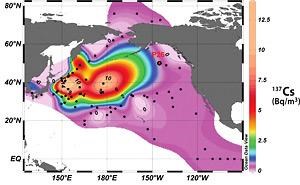BC’s grand chief and First Nation leaders on the Sunshine Coast are supporting a call for Ottawa to “systematically and properly” study the full impact of Fukushima radiation on the West Coast fishery.
Radiation from the March 2011 nuclear accident arrived off the BC coast last year, Robin Brown, ocean sciences division manager with the Department of Fisheries and Oceans (DFO), said Tuesday, February 4.
“According to our observations, the radiation from Fukushima was detected in BC coastal waters in June 2013,” he said. “Barely detectable, but detectable.”
Although the federal government tested food samples, including some domestic fish species, in 2011 and early 2012, the Canadian Food Inspection Agency (CFIA) now reports that “further testing of imported or domestic food products for the presence of radioactive material is not required.”
Last month, Tahltan Central Council president Annita McPhee wrote to National Chief of the Assembly of First Nations in Canada Shawn A-in-chut Atleo, urging him to press Ottawa for action amid growing concerns by members of the Tahltan Nation in northwestern BC.
“We cannot sit by and watch and wait to see what the full impacts of the Fukushima disaster will be on our salmon and our way of life,” McPhee wrote. “To date, we have not seen or heard of Canada taking this issue seriously and working in a real way to address it.”
In an interview, McPhee said news reports about Fukushima have bred fear in her community.
“Some people are not eating their fish because they’re scared,” she said. “Some people don’t want to feed it to their kids. We don’t want to get cancer. We already have lots of cancer up in our area.”
She added the Tahltan people are concerned about what’s going on. “We get our fish from the Stikine River, but it comes from the Pacific Ocean,” she said. “As first nations, we’ve got to come together and address this, force the government’s hand. We have a right to know if our fish is safe to eat.”
BC Grand Chief Stewart Phillip echoed that view, calling the federal government’s inaction “highly irresponsible.
“I think it’s certainly a legitimate concern,” Phillip said. “Other jurisdictions—other countries—realize there is a very real potential for contamination. Unfortunately, Canada doesn’t seem to be taking any steps whatsoever to acknowledge this as a potential threat.”
Instead, Phillip noted, DFO has been downsized, representing “a significant disinvestment” in the West Coast fishery.
Tla’amin (Sliammon) First Nation Chief Clint Williams said he fully backs McPhee’s call for testing and full disclosure.
“Our people really cherish salmon, it has always been part of our culture, so we absolutely encourage that,” he said. “We want to make sure our food is safe. And it’s not just salmon either, it’s clams, geoducks, sea urchins.”
Former shíshálh (Sechelt) Nation chief Calvin Craigan concurred, saying that any contamination of natural foods from the sea will affect coastal native communities. “All first nations have to get together and call for testing,” Craigan said.
Last October, a report by five DFO scientists concluded that, due to ocean currents, “the inventory of Fukushima radioactivity will almost entirely shift from the western to the eastern North Pacific during the next five years.”
The report presented two widely different study models. One model suggested ocean contamination would exceed levels of maximum fallout from nuclear tests and previous accidents such as Chernobyl, while the other model said levels would equal the amount of contamination that existed in 1990.
“These levels are still well below maximum permissible concentrations in drinking water for cesium-137,” the report said. “Not an environmental or human health radiological threat!”
Despite that caveat, the report cited “many reasons for study,” including human health and marine biota.
Brown, one of the co-authors of the report, acknowledged that neither study factored in ongoing discharges from Fukushima after the March 2011 release.
“But there are several lines of evidence,” he added, “to suggest that the ongoing releases, while serious, are small compared to the initial release and will not impact arrival time or peak concentration.”
DFO will continue to test water samples from a line of monitoring stations in the Pacific, Brown said, stressing the low levels that have been detected to date.
Asked if West Coast marine life was being tested, Brown said: “I know Health Canada is doing some kind of research mode measurements. I know they are measuring concentrations in fish.”
When contacted, however, Health Canada referred Coast Reporter to the CFIA, which said tests were conducted on some species in August 2011 and February 2012, and all test results were below Health Canada action limits.
“Based on our test results, as well as our ongoing assessment of information from a variety of expert resources, further testing of imported or domestic food products for the presence of radioactive material is not required,” the agency said in an email response.
“The CFIA continues to monitor events in Japan and assess any potential impacts on Canada’s food supply,” the agency added.



